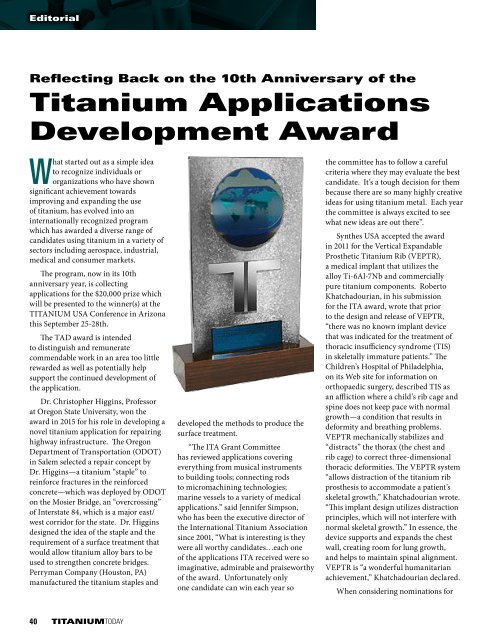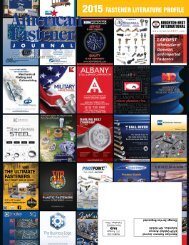100% Positive Material Identification
23mhiW2
23mhiW2
You also want an ePaper? Increase the reach of your titles
YUMPU automatically turns print PDFs into web optimized ePapers that Google loves.
Editorial<br />
Reflecting Back on the 10th Anniversary of the<br />
Titanium Applications<br />
Development Award<br />
What started out as a simple idea<br />
to recognize individuals or<br />
organizations who have shown<br />
significant achievement towards<br />
improving and expanding the use<br />
of titanium, has evolved into an<br />
internationally recognized program<br />
which has awarded a diverse range of<br />
candidates using titanium in a variety of<br />
sectors including aerospace, industrial,<br />
medical and consumer markets.<br />
The program, now in its 10th<br />
anniversary year, is collecting<br />
applications for the $20,000 prize which<br />
will be presented to the winner(s) at the<br />
TITANIUM USA Conference in Arizona<br />
this September 25-28th.<br />
The TAD award is intended<br />
to distinguish and remunerate<br />
commendable work in an area too little<br />
rewarded as well as potentially help<br />
support the continued development of<br />
the application.<br />
Dr. Christopher Higgins, Professor<br />
at Oregon State University, won the<br />
award in 2015 for his role in developing a<br />
novel titanium application for repairing<br />
highway infrastructure. The Oregon<br />
Department of Transportation (ODOT)<br />
in Salem selected a repair concept by<br />
Dr. Higgins—a titanium “staple” to<br />
reinforce fractures in the reinforced<br />
concrete—which was deployed by ODOT<br />
on the Mosier Bridge, an “overcrossing”<br />
of Interstate 84, which is a major east/<br />
west corridor for the state. Dr. Higgins<br />
designed the idea of the staple and the<br />
requirement of a surface treatment that<br />
would allow titanium alloy bars to be<br />
used to strengthen concrete bridges.<br />
Perryman Company (Houston, PA)<br />
manufactured the titanium staples and<br />
developed the methods to produce the<br />
surface treatment.<br />
“The ITA Grant Committee<br />
has reviewed applications covering<br />
everything from musical instruments<br />
to building tools; connecting rods<br />
to micromachining technologies;<br />
marine vessels to a variety of medical<br />
applications.” said Jennifer Simpson,<br />
who has been the executive director of<br />
the International Titanium Association<br />
since 2001, “What is interesting is they<br />
were all worthy candidates…each one<br />
of the applications ITA received were so<br />
imaginative, admirable and praiseworthy<br />
of the award. Unfortunately only<br />
one candidate can win each year so<br />
the committee has to follow a careful<br />
criteria where they may evaluate the best<br />
candidate. It’s a tough decision for them<br />
because there are so many highly creative<br />
ideas for using titanium metal. Each year<br />
the committee is always excited to see<br />
what new ideas are out there”.<br />
Synthes USA accepted the award<br />
in 2011 for the Vertical Expandable<br />
Prosthetic Titanium Rib (VEPTR),<br />
a medical implant that utilizes the<br />
alloy Ti-6Al-7Nb and commercially<br />
pure titanium components. Roberto<br />
Khatchadourian, in his submission<br />
for the ITA award, wrote that prior<br />
to the design and release of VEPTR,<br />
“there was no known implant device<br />
that was indicated for the treatment of<br />
thoracic insufficiency syndrome (TIS)<br />
in skeletally immature patients.” The<br />
Children’s Hospital of Philadelphia,<br />
on its Web site for information on<br />
orthopaedic surgery, described TIS as<br />
an affliction where a child’s rib cage and<br />
spine does not keep pace with normal<br />
growth—a condition that results in<br />
deformity and breathing problems.<br />
VEPTR mechanically stabilizes and<br />
“distracts” the thorax (the chest and<br />
rib cage) to correct three-dimensional<br />
thoracic deformities. The VEPTR system<br />
“allows distraction of the titanium rib<br />
prosthesis to accommodate a patient’s<br />
skeletal growth,” Khatchadourian wrote.<br />
“This implant design utilizes distraction<br />
principles, which will not interfere with<br />
normal skeletal growth.” In essence, the<br />
device supports and expands the chest<br />
wall, creating room for lung growth,<br />
and helps to maintain spinal alignment.<br />
VEPTR is “a wonderful humanitarian<br />
achievement,” Khatchadourian declared.<br />
When considering nominations for<br />
40 TITANIUMTODAY







